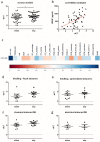An exploratory approach to identify microRNAs as circulatory biomarker candidates for epilepsy-associated psychiatric comorbidities in an electrical post-status epilepticus model
- PMID: 36941269
- PMCID: PMC10027890
- DOI: 10.1038/s41598-023-31017-9
An exploratory approach to identify microRNAs as circulatory biomarker candidates for epilepsy-associated psychiatric comorbidities in an electrical post-status epilepticus model
Abstract
Patients with epilepsy have a high risk of developing psychiatric comorbidities, and there is a particular need for early detection of these comorbidities. Here, in an exploratory, hypothesis-generating approach, we aimed to identify microRNAs as potential circulatory biomarkers for epilepsy-associated psychiatric comorbidities across different rat models of epilepsy. The identification of distress-associated biomarkers can also contribute to animal welfare assessment. MicroRNA expression profiles were analyzed in blood samples from the electrical post-status epilepticus (SE) model. Preselected microRNAs were correlated with behavioral and biochemical parameters in the electrical post-SE model, followed by quantitative real-time PCR validation in three additional well-described rat models of epilepsy. Six microRNAs (miR-376a, miR-429, miR-494, miR-697, miR-763, miR-1903) were identified showing a positive correlation with weight gain in the early post-insult phase as well as a negative correlation with social interaction, saccharin preference, and plasma BDNF. Real-time PCR validation confirmed miR-203, miR-429, and miR-712 as differentially expressed with miR-429 being upregulated across epilepsy models. While readouts from the electrical post-SE model suggest different microRNA candidates for psychiatric comorbidities, cross-model analysis argues against generalizability across models. Thus, further research is necessary to compare the predictive validity of rodent epilepsy models for detection and management of psychiatric comorbidities.
© 2023. The Author(s).
Conflict of interest statement
The authors declare no competing interests.
Figures





